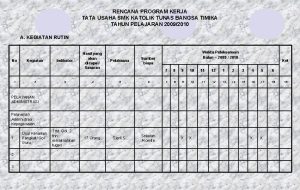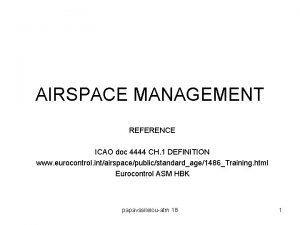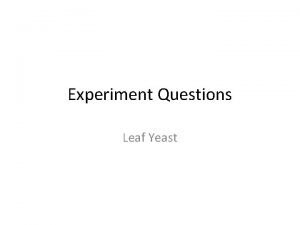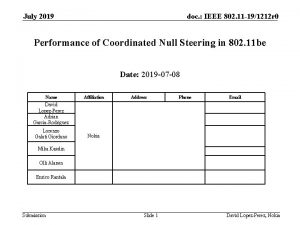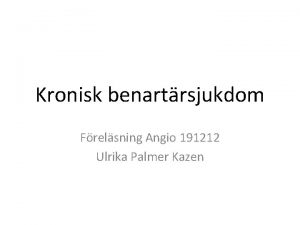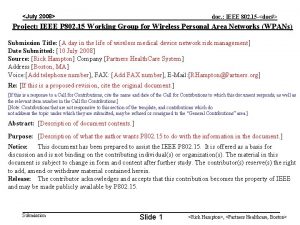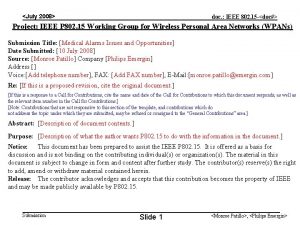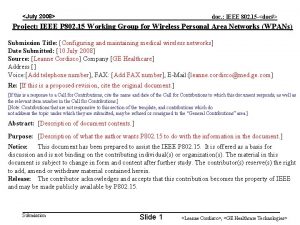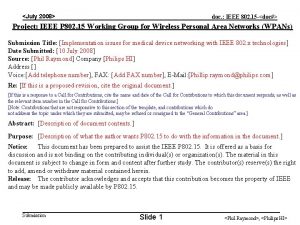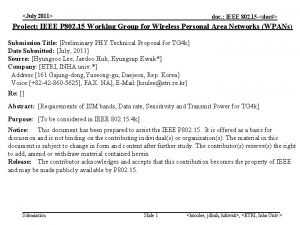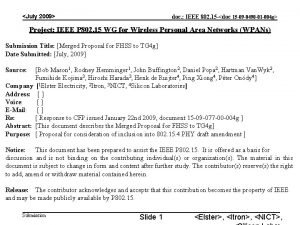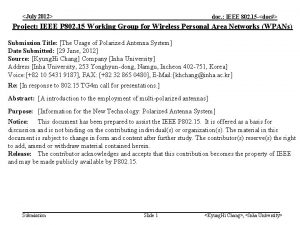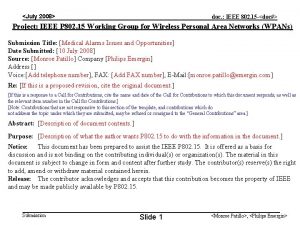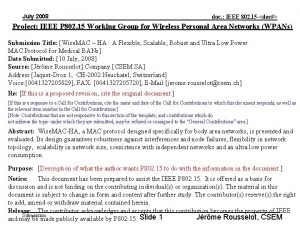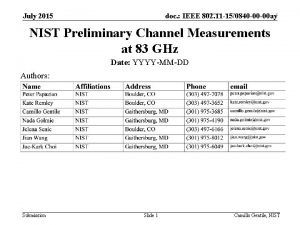July 2019 doc IEEE 802 11 191212 r












![July 2019 doc. : IEEE 802. 11 -19/1212 r 1 References [1] Ron Porat July 2019 doc. : IEEE 802. 11 -19/1212 r 1 References [1] Ron Porat](https://slidetodoc.com/presentation_image_h2/618acbc6b5a51fa389264ba8b10d5271/image-13.jpg)

- Slides: 14

July 2019 doc. : IEEE 802. 11 -19/1212 r 1 Performance of Coordinated Null Steering in 802. 11 be Date: 2019 -08 -22 Authors: Name Affiliation Address Phone Email David Lopez-Perez Adrian Garcia-Rodriguez Lorenzo Galati Giordano Nokia Mika Kasslin Olli Alanen Enrico Rantala Submission Slide 1 David Lopez-Perez, Nokia

July 2019 doc. : IEEE 802. 11 -19/1212 r 1 Introduction • Coordinated beamforming and null steering have attracted considerable attention in previous 802. 11 be meetings [1] Ron Porat (Broadcom), Comparison of Coordinated BF and Nulling with JT, 19/0799 [2] Eunsung Park (LG), Performance Investigation on Multi-AP Transmission, 19/0779 [3] Roya Doostnejad (Intel), Multi-AP Collaborative BF in IEEE 802. 11, 19/0772 [4] Roya Doostnejad (Intel), Implicit Channel Sounding in IEEE 802. 11, 19/0768 [5] Roya Doostnejad (Intel), Implicit Channel Sounding in IEEE 802. 11(Feasibility Study), 19/0767 [6] Sungjin Park (LG), Multi-AP Transmission Procedure, 19/0804 [7] Sigurd Schelstraete (Quantenna), Nulling and coordinated beamforming, 19/0638 [8] Adrian Garcia-Rodriguez (Nokia), Coordinated Null Steering for EHT, 19/0401 [9] Sungjin Park (LG), Multi-AP Transmission Procedure, 19/0448 [10] Sigurd Schelstraete (Quantenna), Nulling and coordinated beamforming, 19/0445 [11] Kome Oteri (Inter. Digital), Coordinated Multi-AP Transmission for EHT, 19/0071 [12] Kiseon Ryu (LG), Consideration on multi-AP coordination for EHT, 18/1982 [13] Sameer Vermani (Qualcomm), Terminology for AP Coordination, 18/1926 Submission Slide 2 David Lopez-Perez, Nokia

July 2019 doc. : IEEE 802. 11 -19/1212 r 1 Introduction • In this contribution, we — Analyse the performance gains introduced by inter-AP coordination and coordinated beamforming/null steering — Consider a scenario with both § broad-band traffic—modelled as a file transfer protocol (FTP) service —, and § low-latency traffic—modelled as an augment reality (AR) application — Study the system performance as a function of § the number of radiation nulls, and § the traffic load — Compare implicit versus explicit CSI acquisition procedures Submission Slide 3 David Lopez-Perez, Nokia

July 2019 doc. : IEEE 802. 11 -19/1212 r 1 When is coordinated beamforming/null steering useful? BB BB • Dense scenarios with high interference — There must be inter-AP interference to null • where, in addition, the served STAs enjoy high SNRs — Placing a radiation null reduces the degrees of freedom (d. o. f. ) for beamforming, and thus the beamforming gain, penalizing cell-edge STAs • where, in addition, the number of spatial streams to serve is reasonably smaller than the available d. o. f. at the antenna array in the AP — As for the Shannon-Hartley theorem, multiplexing gains are linear, while SINR gains are logarithmic in terms of capacity, and the later gains should not come at the expense of the former Submission Slide 4 David Lopez-Perez, Nokia

July 2019 doc. : IEEE 802. 11 -19/1212 r 1 Coordinated null steering in 802. 11 be • • APs with up to 16 antennas Multiple STAs per AP to serve Spectrum shared according to CSMA/CA Under utilization of the array capabilities – number of spatial streams << available spatial degrees of freedom of the array BB BB be am AP 2 am URLLC time sharing APs listen to each other AP 1 BB BB URLLC BB BB BB 802. 11 be with coordinated null steering • Coordination and nulling in place to a) enhance spatial reuse, b) fully utilize the available spatial degrees of freedom of the array, and c) mitigate OBSS interference BB BB be 802. 11 be with no coordinated null steering URLLC nulls simultaneous access APs listen to each other nulls BB URLLC BB BB BB Simultaneous access and interference mitigation at expense of beamforming gain Submission Slide 5 David Lopez-Perez, Nokia

July 2019 doc. : IEEE 802. 11 -19/1212 r 1 System model Frequency/Bandwidth 5. 18 GHz/80 MHz (1 channel) AP deployment Ceiling mounted | Inter-AP distance = 15 m | AP height = 3 m AP characteristics AP Tx power = 24 d. Bm | 8 x 2 antenna array (0. 5λ separation) | omni antenna element | NF = 7 d. B STA deployment 4 broadband STAs/AP (≈5 m from AP) |1 low-latency STA/AP (≈3 m from AP) | STA height = 1 m (see previous figure) STA characteristics STA Tx power = 15 d. Bm | 1 omni antenna | NF = 9 d. B Channel model 3 D spatial channel model (3 GPP TR 38. 901 – In. H [14]) Channel estimation a) Implicit channel est. with perfect CSI (fixed pilot overhead) b) Explicit channel est. with perfect CSI (Uncompressed BF feedback) MAC layer conf. No EDCA | No RTS/CTS | TXOP = 4 ms | IP/MAC header overhead considered | Minstrel MCS selection PHY layer conf. Precoder = MU ZF (with and without nulls) | PHY header overhead considered | Omni PLCP header | 11 ax MCSs X Submission Slide 6 David Lopez-Perez, Nokia

July 2019 doc. : IEEE 802. 11 -19/1212 r 1 Traffic models Broadband STAs Low-Latency STAs FTP 3 traffic model [15] AR traffic model [16] • File size = 0. 5 MBytes • File size = 32 bytes • Frequency = 10 ms constant arrival rate • Offered traffic = [25 50 75 100] Mbit/s exponential arrival rate Per STA traffic time AP 2 AP 1 Mix of broadband low-latency traffic models Submission Slide 7 David Lopez-Perez, Nokia

July 2019 doc. : IEEE 802. 11 -19/1212 r 1 Broadband performance as function of nulls number and offered traffic Implicit CSI • Coordination and null steering provides significant throughput (TP) gains due to — more aggressive spectrum access — inter-AP interference mitigation • For 25 Mbps/STA offered traffic, — 2 nulls provide 43% 5%-tile TP gain w. r. t. no nulling. — Placing more nulls does not improve performance, as the number of simultaneously active STAs is low • For 100 Mbps/STA offered traffic, — 2 nulls provide 76% 5%-tile TP gains w. r. t. no nulling — 3 nulls provide 2. 3 x 5%-tile TP gains — 4 nulls provide 2. 7 x 5%-tile TP gains. — The nulling gain decreases with the number of nulls as the UEs most vulnerable to interference are nulled first Null steering provides significant capacity gains, up to 2. 7 x Submission Slide 8 David Lopez-Perez, Nokia

July 2019 doc. : IEEE 802. 11 -19/1212 r 1 Latency performance as function of nulls number and offered traffic Implicit CSI • Coordination and null steering also provide lower latencies — due to the more aggressive spatial reuse and interference mitigation — Further lower latencies could be achieved through reduced TXOP durations • For 100 Mbps/STA offered traffic, — with 0 nulls, 22% of the low-latency packets do not make it within the 10 ms deadline — with 4 nulls, all low-latency packets make it on time — Further SINR increases due to more nulls do not bring substantial latency advantages, since the low-latency packets are small and utilize low MCSs • TCP/IP will benefit from the ‘narrower’ delay distributions Null steering provides lower latencies and jitter variances Submission Slide 9 David Lopez-Perez, Nokia

July 2019 doc. : IEEE 802. 11 -19/1212 r 1 Implicit versus Explicit CSI acquisition Offered Traffic = 100 Mbps • Explicit CSI is penalized by the overhead of NDPA+NDP+TF+feedback — This overhead grows with the number of spatial streams and nulls scheduled — The more nulls, the larger the overhead • With 0 nulls, implicit CSI provides 28% median TP gains w. r. t. explicit CSI • With 2, 3 and 4 nulls, such gains are 19%, 28% and 36%, respectively • When using explicit CSI, the gain provided by the more nulls may be lost due to CSI acquisition overhead Implicit CSI is desirable to make the most out of null steering Submission Slide 10 David Lopez-Perez, Nokia

July 2019 doc. : IEEE 802. 11 -19/1212 r 1 What does coordinated null steering require? APs with multiple antennas EHT No severe spatial channel correlation among STAs EHT Efficient CSI acquisition procedures EHT Methods to acquire CSI from STAs served by other APs Coordination procedures for null steering transmissions EHT in line with other EHT targets more specific work required Submission Slide 11 David Lopez-Perez, Nokia

July 2019 doc. : IEEE 802. 11 -19/1212 r 1 Conclusions • In this contribution, we analysed the performance gains introduced by coordination and null steering — Null steering provides significant throughput gains—up to 2. 7 x— and latency reductions— 22% more packets meet their deadlines— due to both § More aggressive spectrum access § Inter-AP interference mitigation — Null steering significantly benefits from implicit CSI—up to 36% throughput gains—, as the overhead incurred by explicit CSI acquisition to place a null may counteract its SINR benefits. Submission Slide 12 David Lopez-Perez, Nokia
![July 2019 doc IEEE 802 11 191212 r 1 References 1 Ron Porat July 2019 doc. : IEEE 802. 11 -19/1212 r 1 References [1] Ron Porat](https://slidetodoc.com/presentation_image_h2/618acbc6b5a51fa389264ba8b10d5271/image-13.jpg)
July 2019 doc. : IEEE 802. 11 -19/1212 r 1 References [1] Ron Porat (Broadcom), Comparison of Coordinated BF and Nulling with JT, 19/0799. [2] Eunsung Park (LG), Performance Investigation on Multi-AP Transmission, 19/0779. [3] Roya Doostnejad (Intel), Multi-AP Collaborative BF in IEEE 802. 11, 19/0772. [4] Roya Doostnejad (Intel), Implicit Channel Sounding in IEEE 802. 11, 19/0767. [5] Roya Doostnejad (Intel), Implicit Channel Sounding in IEEE 802. 11(Feasibility Study), 19/0767. [6] Sungjin Park (LG), Multi-AP Transmission Procedure, 19/0804. [7] Sigurd Schelstraete (Quantenna), Nulling and coordinated beamforming, 19/0638. [8] Adrian Garcia-Rodriguez, Coordinated Null Steering for EHT, 19/0401. [9] Sungjin Park (LG), Multi-AP Transmission Procedure, 19/0448. [10] Sigurd Schelstraete (Quantenna), Nulling and coordinated beamforming, 19/0445. [11] Kome Oteri (Inter. Digital), Coordinated Multi-AP Transmission for EHT, 19/0071. [12] Kiseon Ryu (LG), Consideration on multi-AP coordination for EHT, 18/1982. [13] Sameer Vermani (Qualcomm), Terminology for AP Coordination, 18/1926. [14] 3 GPP TR 38. 901, “Study on channel model for frequencies from 0. 5 to 100 GHz, ” Jun. 2018. [15] 3 GPP TR 36. 814, “Evolved Universal Terrestrial Radio Access (E-UTRA); Further advancements for E-UTRA physical layer aspects, ” Mar. 2017. [15] 3 GPP TR 38. 824, “Study on physical layer enhancements for NR ultra-reliable and low latency case (URLLC), ” Mar. 2019. Submission Slide 13 David Lopez-Perez, Nokia

May 2019 doc. : IEEE 802. 11 -19/1212 r 1 Appendix Submission Slide 14 David Lopez-Perez, Nokia











